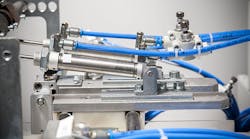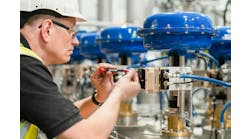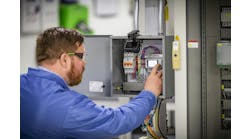Now that factories can have pneumatics gathering process data from previously unintelligent valves, cylinders and air-preparation units, what kind of insights from this connectivity are helping to reduce downtime and increase productivity?
With smart valves and other pneumatic components, the common parameters that users measure are air pressure at any given point, pressure drops, air flow, position of a cylinder rod, and presence or absence of an object on an assembly line.
Checks and balances within the control system determine whether these processes meet expectations, and when they do not an alert gets sent out. There are different bits of information these smart pneumatic components can pick up on to determine if there are leaks or pressure drops, if filters are getting dirty and need replacing or even if a cylinder is not performing according to design. The data from the pneumatic system helps to determine when an actuator needs to act and when the system needs to be shut down in case of emergency. There are advantages in safety, performance and energy efficiency.
IO-Link for IIoT
The emergence of the IO-Link for Industrial Internet of Things (IIoT) applications has made it easier to integrate pneumatics into an automation system with significant benefits.
IO-Link incorporates standardized function blocks and automated parameter settings to allow easier and more efficient integration of the components into the IIoT system.
IO-Link generally monitors everything, using the feedback from the pneumatics, to know how the different parts of the system are working. For troubleshooting, it knows what a particular cylinder is doing and what kind of pressure is needed for, say, a clamping application. It knows everything it needs to know in order to determine whether a particular process is operating as planned.
The IO-Link runs parallel with CANopen type of systems and proprietary fieldbus networks. People will jump online with Profibus, DeviceNet or EtherNet/IP, rather than having the extra IO-Link. IO-Link makes more sense to have when you produce a lot of redundant products, such as sensors or valves. If you are not producing 100 or more of each component, your cost per point would be too high. The more you produce, the more it makes sense. IO-Link may be more advantageous with conveyor systems, for example, where you have long runs of cylinders and valves needed for the whole system.
IO-Link-capable products have been slow taking off in terms of sales, mostly due to cost. A lot of pneumatic circuitry is pretty simplistic and many manufacturers may not need all the technology IO-Link enables.
Until larger OEMs jump onboard, we expect uptick to remain slow because cost is so important for these smaller manufacturers to stay competitive. If they can get away with not having that monitoring system, such as at a box plant or something similar, they will hold off on adopting IO-Link until they see a major benefit.
Another scenario for a quicker adoption will be if they have to replace equipment and buy a new machine with this type of technology integrated in it. They would then need to understand it and use it.
Fieldbus interfaces
The incorporation of fieldbus interfaces and I/O capability have made pneumatic valve manifolds more versatile for automation platforms.
The serial/interface (S/I) unit or fieldbus interface allows the valve manifold to communicate with a PLC, and I/O units allow sensors and other devices to communicate with the PLC to help control the pneumatic system.
This enables more feedback opportunities for the pneumatic system. The S/I unit and I/O units also reduce the wiring needed for the system. The S/I units or fieldbus interface use a two-wire, twisted-pair type of cabling. This reduces the wiring needed to connect valves.
Before fieldbus, you had point-to-point wiring, which required bundles of wires going to separate valves. With a fieldbus manifold, you have point-to-multipoint wiring where you can have more than 20 valves on a manifold but only need one cable to connect all 20 to the PLC. Plus, many manifolds are plug-and-play, which adds to the flexibility.
Prior to this innovation, if you had a four-station manifold and needed to add another valve, because it was all hardwired you had to add another manifold, rather than just adding a station on the existing manifold. Now, all you have to do is take the end cap off of the manifold, plug a new one in and reconfigure it on the PLC or fieldbus master.
Energy consumption
The continuing emphasis on energy management and greater availability of sensors in pneumatic systems is changing the way pneumatic systems operate.
Valving has expanded to a point where some products enable 70% less energy consumption to run certain applications. This is changing the way air supplies are distributed throughout the system. More solid-state electronics are being implemented inside the unit, and smarter microprocessor units are being used to gain feedback that tells how much pressure is inside the valves. Feedback can be used to minimize energy consumption, such as dialing down to the minimum energy needed to switch the position of the spool inside a valve, and boosting energy or line pressure only when and where needed.
In addition to gains in energy efficiency and production, there has been a lot more emphasis on safety. For example, if you have a cylinder in a vertical operation and lose power, if you don’t have a way to stop that motion, gravity will drop down that piece on someone’s hand or break a multimillion-dollar piece of equipment. Manufacturers offer services to evaluate what could go wrong with your machines and suggest how to make your operations as safe as possible, with certified documentation to prove your setup is fail-safe.
Predictive maintenance
Smart pneumatics can play a role in predictive maintenance and monitoring and improving overall equipment effectiveness (OEE).
With the number of sensors and amount of feedback coming from the pneumatics system, maintenance personnel are able to diagnose problems more quickly and thereby decrease downtime and make the system more efficient. Monitoring pressure drops in various locations in the circuit can help to pinpoint where leaks are and if filters may be dirty. Pressure drops can also indicate if seals are worn on a component.
Keeping track of how often a cylinder or other product is used can help to determine if it has reached the end of its lifecycle. Monitoring and regulating the pressure used at any given point can also save on wear and tear on the components and save on energy costs, as well. Many filter-regulator-lubricator (FRL) units are easier to read and disassemble/assemble, making it easier to know when to service them. Pressure switches often have larger multi-line displays, offering more information instantaneously, and are more readable at a distance, making monitoring much easier.
Miniaturization
Miniaturizing pneumatic components enables more innovation in the IIoT world. It saves on space and weight. This is especially helpful with robotics and robotic arms, because you want as little weight as possible for the movement and function.
Manufacturers are expanding greatly into the mini-pneumatics area. While larger robotics have been prevalent in the automotive industry and used for other heavy-load applications for years, we are seeing a significant increase in smaller collaborative robots that handle lighter loads.
Collaborative robots (cobots) work in unison with humans, so they are picking smaller pieces and assembling into a fixture or power supply that needs to be welded or soldered. The miniaturization is important in the semiconductor industry where robotics deal with very thin wafers that can be difficult to pick on an assembly line.
Having smaller, lighter products inside the robotics, in addition to reduced wiring, gives you more options for design and use of the applications themselves.
Without this miniaturization, the products would be too heavy to allow the robotic arms to function the way you want them to. The lower weight can also help with transportability for portable applications, such as robotics in the medical industry. With the COVID-19 pandemic, small pneumatic components were needed for the patient ventilators, as well as the wearable respirators healthcare personnel were using.




